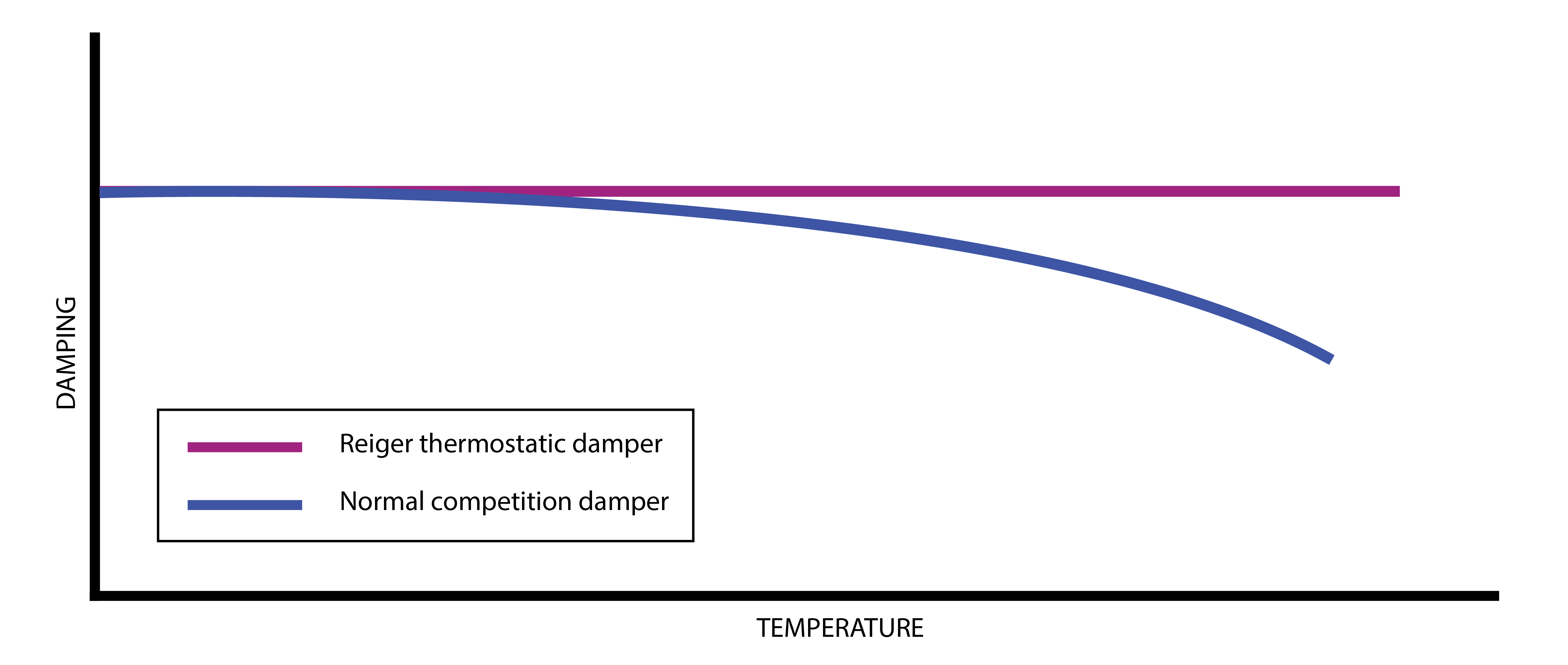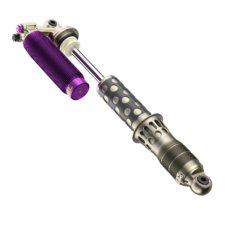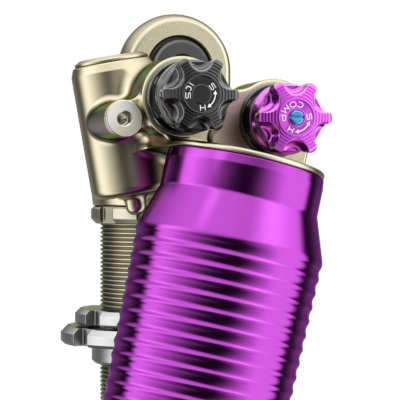Compression adjustment in general
Compression describes the movement of compressing the shock absorber; with our adjustable compression damping we can adjust, how fast the shock absorber compresses. Opposed to what many people think, high- and lowspeed compression adjustment has nothing to do with the speed of the vehicle. It describes the velocity of the pistonrod while taking a impact. Fast velocities occur while driving over small bumps and uneven surface, low velocities are typically connected to big impacts and body movement of the vehicle.
These adjustments are always counted from completely closed position.
Highspeed Compression adjustment (Purple hand wheel)
With the highspeed adjustment we control high pistonrod velocities, for example while driving through uneven terrain or over smaller bumps and ondulations. This adjustment is key for generating grip and also comfort, which are directly linked to each other.
Lowspeed Compression adjustment (Green flathead screw)
With the lowspeed adjustment we control the body movements of a vehicle, such as rolling while taking a corner or pitching forward under braking. We can support the vehicles body mass against the surface and therefor determine how the car turns in and handles in general as well as how much support it offers on big impacts and landings.
Rebound adjustment
Rebound describes the movement of extending the shock absorber; with rebound damping we can adjust how fast the shock absorber extends.
Rebound needs to control the springs otherwise uncontrolled movement and helps to connect the vehicle to the ground at all times. Therefore rebound adjustment is crucial in high performance applications to exactly dial in the cars behavior. With the rebound adjustment we control both, comfort of the vehicle and the body movement.
Rebound adjusters vary in appearance and position depending on the shock type and application. They can be found at the bottom of the pistonrod as hand wheels or flat head adjusters or as purple hexagonal adjusters at the top of the shock absorber.
CCV = Corner Control Valve
The patented Corner Control Valve is a Reiger exclusive adjustment for the behavior of vehicles while under cornering forces. As soon as a vehicle turns in it is subjected lateral g-forces. With this, the CCV comes into action and switches into an alternate damping curve, that is seperately adjustable. With help of the CCV the vehicles roll movements and overall damping characteristics in a corner can be fine tuned to find even more grip and go faster.
CCV adjusters are black hand wheels near the compression adjusters and marked accordingly.
RCV = Rebound Control Valve
Much like the CCV system, the RCV is capable of adjusting the suspension in accordance to the situation of the vehicle. With RCV a shock absorber can detect if the wheel is touching the ground or hanging in the air. If the wheel does not have contact with the surface, the system automatically switches into a faster rebound damping curve, extending the wheel as fast as possible to touch ground and gain traction. This system helps on bumpy surfaces and the occasional washboard section to gain maximum traction without sacrificing speed on other sections, as it is only active when the wheel does not have ground contact.
RCV comes with a fixed, damper specific setting and cannot be adjusted.
DP = Double Piston
The Double Piston system allows for a position sensitive, progressive compression damping curve. The DP has a fixed engagement point within the dampers travel. At this set point in the dampers travel, the DP engages with the regular piston of the damper and changes the compression charateristic to a setting with more damping. This means that there is more damping further down the stroke, for example for big impacts such as jumps. The vehicle can retain a comfortable ride quality while still being able to absorb harsh impacts.
DP is not adjustable, but set to the specific needs of each vehicle.
The option DP can not be combined with HDP.
HDP = Hydraulic Double Piston
As an evolution of the DP system, the HDP has the same basic functionality but is layed out with a smoother hydraulic charateristic, smoothing out the engagement point and therefore change in the compression charateristic of the damper. It is more sophisticated than the DP system and offers an even smoother progression between the two travel zones of the shock absorber.
HDP, like DP is not adjustable but set up specifically for each application.
The option HDP can not be combined with DP.
ICS = Intelligent Compression System
The ICS system is used to control the vehicles behavior while landing and jumping. As soon as the vehicle is jumping, the ICS is activated and and switches into a seperate damping curve, that also is adjustable individually. With ICS we generate much plusher landings, more comfort for the rider or driver and more traction while landing.
ICS adjusters are marked accordingly and are mostly black handwheels next to the compression adjusters.

Thermostatic Compensation
A damper transfers kinetic energy into heat. With this process, a damper can reach high temperatures, making the oil hot and chaging it’s viscosity. In essence the oil gets thinner the hotter it gets and therefore runs through the hydraulic circuit faster. To compensate for this, all Reiger dampers use a thermostatic adaption system, that changes the damping in accordance to the temperature. With thermostatic compensation, the damper adapts itself automatically and works with the same damping curve in every temperature range.



























